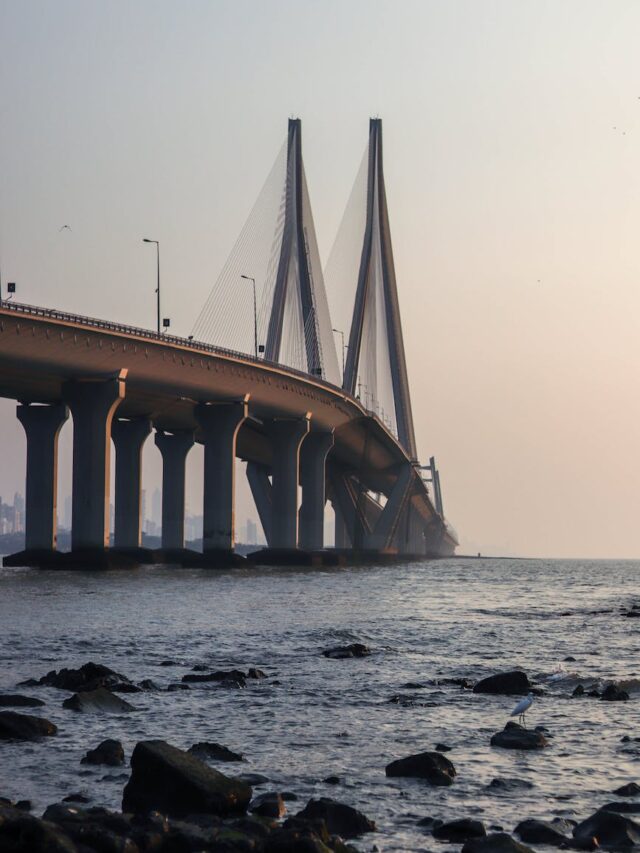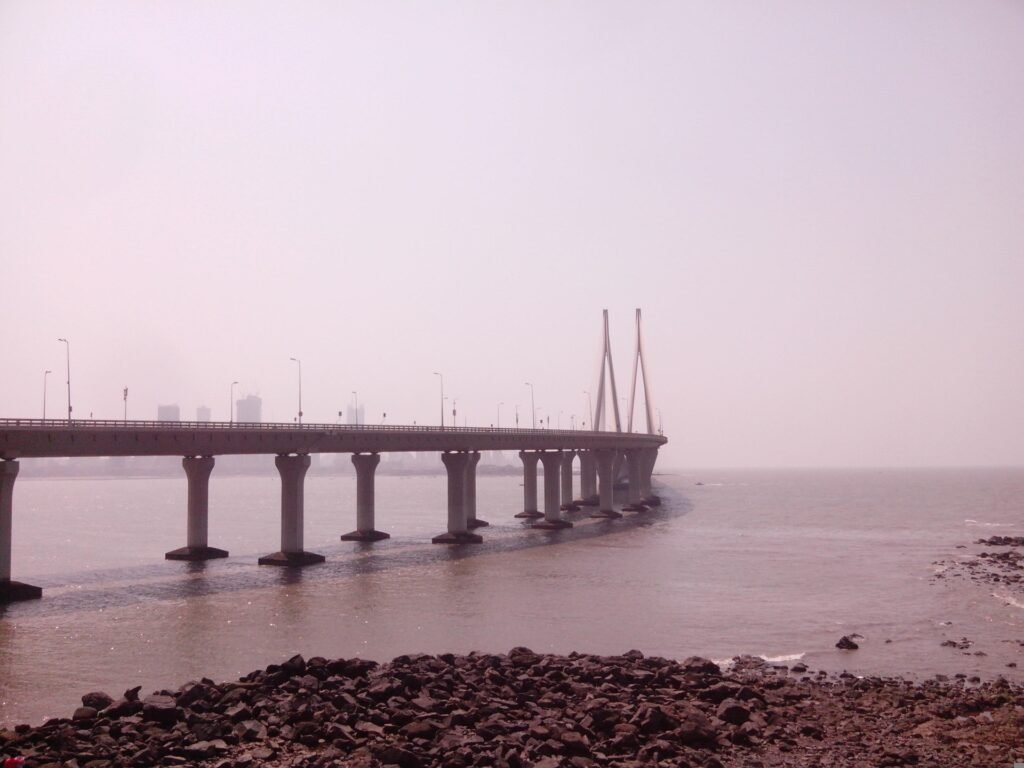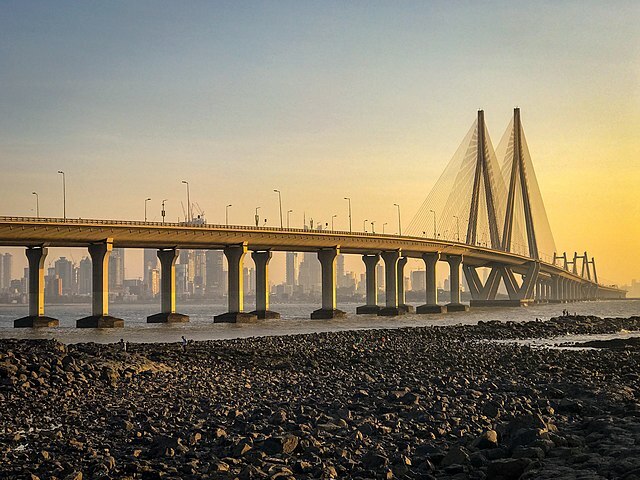The Bandra-Worli Sea Link, also known as the Rajiv Gandhi Sea Link, is a remarkable engineering feat that connects the western suburbs of Mumbai with the central business district of the city. It is the longest sea bridge and the fourth longest bridge in India, spanning 5.6 km over the Mahim Bay. It is also the first cable-stayed bridge across a sea and the first sea link bridge constructed using only precast segments in India. In this article, we will explore the history, design, construction, and benefits of this iconic structure that has become a symbol of Mumbai‘s modernity and progress.
Table of Contents
History of the Bandra-Worli Sea Link

Mumbai, the commercial capital of India, is a densely populated city that faces severe traffic congestion and pollution problems. The Mahim Causeway, which was built in 1845, was the only road connecting the western suburbs to the central business district of Mumbai. This north-south corridor became a bottleneck and was highly congested at peak hours, taking up to an hour to cross.
To ease the traffic woes and provide an alternative route, the Western Freeway project was proposed in 1999 to span the entire western coastline of Mumbai from Nariman Point to Kandivali. The Bandra-Worli Sea Link was planned as the first phase of this freeway system, offering a bridge over Mahim Bay that would reduce travel time between Bandra and Worli from 20-30 minutes to 10 minutes.
The project was commissioned by the Maharashtra State Road Development Corporation (MSRDC) and built by Hindustan Construction Company (HCC). The construction started in 2000 and was completed in 2009. The first four lanes of the bridge were opened to public on June 30, 2009, and all eight lanes were opened on March 24, 2010. The bridge was named after Rajiv Gandhi, the former Prime Minister of India, in 2012.
Design of the Bandra-Worli Sea Link

The Bandra-Worli Sea Link consists of two parallel independent four-lane carriageways for northbound and southbound traffic. Each carriageway has two cable-stayed bridges along its alignment, making it a masterpiece in bridge aesthetics. The cable-stayed bridges have single central pylons that rise gracefully towards the sky, supporting two main spans of 250 m each. The pylons are 126 m high and have a diamond shape that reflects light during day and night.
The bridge also has pre-stressed concrete-steel viaducts on either side of the cable-stayed bridges, with lengths ranging from 300 m to 600 m. The viaducts are made of precast segments that are joined together by post-tensioning. The segments are cast at a casting yard near Bandra and transported by barges to the site. The segments are then lifted by cranes and placed on temporary supports before being stressed together.
The bridge has a total of 2342 precast segments, weighing up to 140 tons each. The segments have an aerodynamic shape that reduces wind resistance and enhances stability. The segments also have drainage pipes, lighting fixtures, fire-fighting systems, and expansion joints embedded in them.
The foundation of the bridge consists of reinforced concrete piles that are driven into the basalt rock below the seabed. The piles have diameters ranging from 1.2 m to 2 m and lengths ranging from 6 m to 34 m. The piles are tested for strength using Osterberg cell technology, which was used for the first time in India for this project.
The bridge has a 16-lane toll plaza at Bandra end with a 20 m wide walkway for pedestrians and cyclists. The toll plaza has traffic monitoring, surveillance, information, and control systems that regulate traffic flow and ensure safety. The toll plaza also has an emergency lane for ambulances and fire engines.
Significance

The Bandra-Worli Sea Link is a significant landmark of Mumbai and India. It has reduced the travel time between Bandra and Worli from one hour to just 10 minutes. The bridge has also improved connectivity between Mumbai’s western suburbs and South Mumbai, which was previously only accessible by road through the Mahim Causeway. The bridge has also become a symbol of India’s modernization and progress.
How to rich Bandra-worli sea link

The Bandra-Worli Sea Link is easily accessible by road and is well-connected to different parts of Mumbai. Here are a few ways to reach the bridge:
- By Taxi or Car: Visitors can hire a taxi or take their own car to reach the Bandra-Worli Sea Link. The bridge is located on the Western Express Highway, making it easily accessible from both Bandra and Worli.
- By Bus: The Mumbai Metropolitan Region Development Authority (MMRDA) operates several buses that connect Bandra and Worli. Visitors can take these buses to reach the bridge.
- By Train: Visitors can take a train to either Bandra or Worli station and then take a taxi or bus to reach the bridge.
- By Metro: The Mumbai Metro line 3 (Colaba-Bandra-SEEPZ) will have a station near the Bandra-Worli Sea Link, making it a convenient mode of transportation once it is operational.
Benefits of the Bandra-Worli Sea Link
The Bandra-Worli Sea Link has brought many benefits to Mumbai and its citizens. Some of them are:
- It has reduced travel time between Bandra and Worli from 20-30 minutes to 10 minutes, saving fuel and time for commuters.
- It has reduced traffic congestion and pollution on Mahim Causeway and other roads leading to it.
- It has improved connectivity between western
Challenges Faced
The construction of the Bandra-Worli Sea Link was not without its challenges. The construction work was hampered by several obstacles, including environmental concerns, financial constraints, and logistical issues. The challenges faced during the construction of the bridge are discussed below.
Environmental Concerns
The construction of the Bandra-Worli Sea Link was a major environmental concern as it involved building a bridge over the Arabian Sea. Environmentalists were concerned about the impact of the construction work on marine life and the sea’s ecosystem. The construction work was also criticized for the damage it caused to the mangrove forests along the coast. The project was delayed several times due to environmental concerns and protests by activists.
Financial Constraints
The construction of the Bandra-Worli Sea Link was a massive project that required substantial funding. The project was initially estimated to cost around Rs. 1,300 crores, but the final cost exceeded Rs. 1,600 crores. The construction work was also delayed due to financial constraints, with the MSRDC facing difficulties in securing funding for the project.
Logistical Issues
The construction of the Bandra-Worli Sea Link was a complex logistical challenge. The bridge’s construction involved the transportation of construction materials and equipment over the sea, which posed a significant challenge. The project also faced several delays due to logistical issues, including the unavailability of equipment and labor.
Despite the challenges faced during its construction, the Bandra-Worli Sea Link stands today as a testament to India’s modernization and progress.
Tourist attraction
The Bandra-Worli Sea Link has become one of the most popular tourist attractions in Mumbai since its opening in 2009. The bridge offers a unique and stunning view of the Arabian Sea, the Mumbai skyline, and the Haji Ali Dargah, making it a must-visit destination for both locals and tourists alike.
The Iconic Mumbai Skyline
The Bandra-Worli Sea Link provides a magnificent view of the Mumbai skyline. The bridge’s unique design and location allow visitors to witness the city’s architectural marvels, including the Taj Mahal Palace Hotel, the Gateway of India, and the Rajabai Clock Tower.
Haji Ali Dargah
The Haji Ali Dargah is a famous mosque located on an islet off the coast of Worli. The Bandra-Worli Sea Link provides an excellent view of the mosque, making it a popular tourist spot. The mosque is a prime example of the Islamic architectural style and is visited by people of all faiths.
Scenic Views of Arabian Sea
The bridge offers breathtaking views of the Arabian Sea, making it a popular spot for photography enthusiasts. The sea link is a perfect place to watch the sunset, and the sea breeze adds to the overall experience.
FAQ’s
How long is the Bandra-Worli Sea Link?
The Bandra-Worli Sea Link is 5.6 kilometers long, including the cable-stayed bridge section.
What is the best time to visit the Bandra-Worli Sea Link?
The best time to visit the Bandra-Worli Sea Link is during the evening, just before sunset. The view of the Mumbai skyline during this time is breathtaking.
Can I take my car on the Bandra-Worli Sea Link?
Yes, cars are allowed on the Bandra-Worli Sea Link. However, there is a toll fee for using the bridge.
Conclusion:
In conclusion, the Bandra-Worli Sea Link is a remarkable engineering feat that has transformed the Mumbai skyline. The bridge connects the suburbs of Bandra and Worli and has become a significant landmark in the city. The Bandra-Worli Sea Link has not only reduced the travel time between the two suburbs but also provided a beautiful view of the Arabian Sea and the Mumbai skyline. The bridge has also become a popular destination for fitness enthusiasts who enjoy walking and cycling along its pedestrian walkway and cycle track.
Additionally, the bridge’s unique design and location provide an excellent view of the Haji Ali Dargah, making it a must-visit destination for tourists. Overall, the Bandra-Worli Sea Link is an iconic structure that showcases Mumbai’s architectural brilliance and deserves a spot on any traveler’s itinerary when visiting the city.


